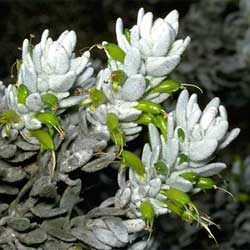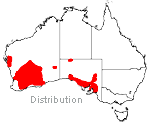Eremophila subfloccosa
 |
 |
Dense-felted Eremophila
Eremophila subfloccosa Benth. (1870)
Eremophila subfloccosa (Dense-felted Eremophila) is a beautiful foliage plant. It is a low, spreading, many branched shrub 0.5 to1 m in height by 1-2 m wide. The young growth is densely hairy making it soft and velvety to the touch. Leaves are grey-green to grey-white, ovate-oblong to elliptical-oblong, alternate, 20 to 40 mm long by 8 mm wide, with entire margins.
The tubular flowers of Eremophila subfloccosa appear singly in axils. Approximately 25 mm long, they are greenish-yellow in colour with prominent protruding stamens. Flowers appear in spring and bloom for approximately 8 to12 weeks. The glabrous fruits are almost globular, 5 to10 mm in diameter.
 The Eremophila genus is endemic to Australia, comprising approximately 200 species and is part of the Scrophulariaceae (previously Myoporaceae) family. This genus is known by its common name of Poverty Bush or Emu Bush which refers to the fruits being a popular food for emus. Distribution of Eremophila subfloccosa is mostly in the Eyre Peninsula in South Australia and the semi arid areas of Western Australia. This genus grows in sandy soils, gravel, clay, loam and laterite on undulating plains, margins of salt lakes and disturbed roadsides.
The Eremophila genus is endemic to Australia, comprising approximately 200 species and is part of the Scrophulariaceae (previously Myoporaceae) family. This genus is known by its common name of Poverty Bush or Emu Bush which refers to the fruits being a popular food for emus. Distribution of Eremophila subfloccosa is mostly in the Eyre Peninsula in South Australia and the semi arid areas of Western Australia. This genus grows in sandy soils, gravel, clay, loam and laterite on undulating plains, margins of salt lakes and disturbed roadsides.
Eremophila subfloccosa can be grown in a range of soil types but thrives in alkaline soils. This species is marginally frost hardy but does not like humidity. It requires excellent drainage in an open sunny position with plenty of air movement. Although E. subfloccosa can be difficult to establish, once established, it generally does not require artificial watering. However, during extremely dry periods, it responds well to deep soakings.
Pests are not a major problem with Eremophila subfloccosa but it can suffer from attack by the fungal diseases of Botrytis spp. and Alternaria spp. The best method of avoiding fungal diseases is to grow plants in open areas allowing plenty of air movement and sunshine.
Application of fertilisers is not usually necessary but a general fertiliser with low phosphorus suitable for native plants can be applied in spring to encourage flowering and vigorous growth. Promotion of healthy, vigorous growth may help plants withstand fungal attack. Regular light pruning also encourages vigorous growth.
Eremophila subfloccosa may be propagated from tip cuttings in spring and half-hardened cuttings in autumn. E. subfloccosa has also been successfully propagated by grafting on rootstock of Myoporum montanum. Attractive horticultural features of Eremophila subfloccosa include the growth habit, foliage and unusual flowers. E. subfloccosa would be an ideal plant in theme gardens such as a sensory garden due to the soft and velvety foliage and a silver and/or water-wise garden taking advantage of the combination of the beautiful grey-green foliage and reduced water needs of this plant. E. subfloccosa can also make an excellent container plant thus allowing the plant to be grown in areas where in ground cultivation conditions are unsuitable.
Text by Dianne Glen (2006 Student Botanical Intern)
Photos: (top) M.Fagg, APII A-20026; (below) D.Glen
Derivation of name: Eremophila subfloccosaEremophila – from the Greek eremos, meaning desert, lonely places, and phileo,meaning to love, in reference to the preferred habitat of many species. subfloccosa – from Latin floccosus, meaning with tufts of soft hairs, having the appearance of matted woolly hairs. |
References:
ABC Gardening Australia: flora’s native plants. The definitive guide to Australian plants, over 1800 plants . 2004. ABC Books, Ultimo, NSW
Elliot, W. R. & Jones, D.L. 1984. Encyclopedia of Australian plants suitable for cultivation. Vol. 3 . Lothian, Melbourne
Paczkowska, G. & Chapman, A.R. 2000. The Western Australia flora: a descriptive catalogue. Wildflower Society of Western Australia (Inc.), the Western Australian Herbarium, CALM and the Botanic Gardens & Parks Authority, Perth.
Society for Growing Australian Plants (South Australian Region). 1997. Eremophilas for the garden. Soc. For Growing Aust. Plants (SA Region)
![An Australian Government Initiative [logo]](/images/austgovt_brown_90px.gif)

